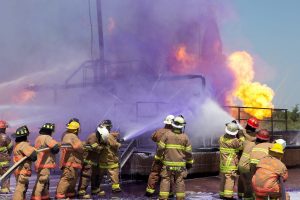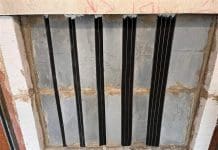Sprinkler technology is moving forwards and in the wake of the Grenfell Tower disaster, controls are rightly getting stricter. How can companies ensure their buildings and employees are protected, and their sprinkler systems are fully compliant? Paul Berry, director at Johnson Controls, takes a look
Following the Grenfell Tower disaster, the fire and building management industries have seen an increased focus on sprinklers, their role in fire suppression and the importance of regular maintenance. The London Fire Brigade has recommended that all high-rise residential buildings should be fitted with them, and the commercial sector is not far behind in its assessment of the situation.
The Grenfell Inquiry, due to publish its initial findings by Easter, is planning to look into current practices and legislation in order to advise on changes and actions that will help to improve safety across the board.
In the wake of this renewed effort to get fire suppression right, building managers need to be able to demonstrate that their safety programme and sprinkler system are up to scratch and able to provide comprehensive protection.
But for all the new discussion of sprinklers, the technology behind them has remained relatively untouched for decades – temperatures of more than 68 degrees causes a bulb in the nozzle to fracture, discharging water through the sprinkler. The quicker the response, the better, and the hardware has been proven to work, controlling or extinguishing a fire as soon as possible. A well-maintained sprinkler system should prevent fires from ever growing larger than a small fire in a bin, and these basic components do prevent further damage.
The question is, what measures can fire safety and suppression teams put in place to ensure that their sprinkler systems are up to scratch? There are four key areas for consideration: integration, intelligence, regulatory compliance and choosing the right technology partner to help you with an install or upgrade.
 Effective integration
Effective integration
One prime way to improve the effectiveness of sprinkler systems is to integrate them into a wider network of fire and safety systems across a building. With the rise of IP-enabled devices that can communicate with one another, from smoke detectors to CCTV cameras, there is a whole host of new opportunities opening up to safety teams both in terms of efficiency and available services.
By managing your whole fire and security landscape through a single, centralised platform or control system, you can widen your insight into what’s going on around the site and help decrease the admin load on frontline staff. The integration of smart systems can provide facilities managers with deeper insights, faster situational judgement and reduced administration workloads, which carry the dual benefit of an improved health and safety regime and a better bottom line. Building management systems can also be monitored offsite, often in groups, to consolidate administration and reduce outlay while maintaining an overview of a site.
Using intelligent devices
Alongside better efficiency, one great benefit of IP-connected safety devices is the data that comes with them. By connecting sprinkler systems to intelligent devices throughout the building, safety teams can gain access to monitoring data from offsite and receive regular updates on any anomalies or alerts. This has multiple benefits: the obvious increased safety for people and assets in the building, a reduced need for on-site teams to physically investigate incidents and improved convenience for on-duty safety personnel.
Current incarnations can incorporate intelligent alert systems, which are particularly useful for security managers’ night rotations. Take a warehouse that is manned by operational staff – during the day, an alarm sounding or a sprinkler activating will be quickly noticed, but during unmanned hours, an alarm may not be noticed for a much longer period of time, increasing the chance of a fire getting out of control.
Connected and intelligent sprinkler systems can send signals out to responsible persons’ iPads or phones, via text message, app alerts or whichever method is most useful. That in turn helps to provide the earliest possible warning, enabling site teams to catch a potential fire before it develops into a large or uncontrollable blaze.
Compliance challenges
No amount of technology, however, is enough on its own. It’s essential that fire safety teams and building managers carefully consider how equipment and installations will help them achieve regulatory compliance. Regulatory compliance should never be a box-ticking exercise, concerned only with the letter of the law. The ultimate aim, after all, is to reduce health and safety risk to the lowest possible level.
As a result, those responsible for fire safety must make sure that they are aware of all areas of responsibility covered by the relevant regulations. It’s not just a matter of installing sprinkler systems; servicing, maintenance, system design and operation must all be properly attended to. Safety teams must ensure that all sprinkler systems are kept in full working order, checking components on a regular basis and running simulations where possible. Regular hazard reviews and testing carried out by certificated companies are essential, and your systems must be checked by qualified engineers.
There should also be an attitude of honesty when it comes to upgrades and change – if a system fails to meet regulations or has degraded over time, then cost worries must come second to compliance.
Partnering up
That doesn’t have to mean that there is a black and white choice between safety and a satisfactory balance sheet. By working with an expert fire suppression provider, businesses can achieve regulatory compliance at a workable price point through a combination of intelligent integration, admin reduction and personalisation.
In the rush to avoid repeating the mistakes of Grenfell, there is certainly a risk that some fire safety teams may settle for less well-resourced suppliers, or those without the expertise required to sufficiently future-proof essential sprinkler systems. To avoid this, companies should be looking for professional organisations with a proven track record of successful installation – who can be product agnostic if needs be – to install and service the correct equipment for the job.
A full-service offering is a positive sign that points to a good provider – a consultative organisation that can assess needs and create solutions accordingly, specific to particular environments and systems, is key to achieving compliance and reducing risk. Companies who can provide installation, servicing and long-term maintenance across an entire site or facility are most likely to provide the right solutions.
Conclusion
It’s no longer up for discussion whether buildings should install sprinkler systems for optimum safety. Building teams must take action now to ensure they have reliable, intelligent and integrated systems in place to protect occupants and assets. New technology is becoming available that can help with that, so the right provider is a must. But at the heart of this issue is an honest approach to maintenance and installation – companies must not cut corners when it comes to fire suppression.
Paul Berry
Director
Johnson Controls
Twitter: @tyco_ifs_UKI




![[VIDEO] Making DorTrak reports easy to read with Fireco Inspecting fire doors at Fireco, firedoor technology, 2023](https://www.pbctoday.co.uk/news/wp-content/uploads/2024/04/JPZ_2364-web-218x150.jpg)









